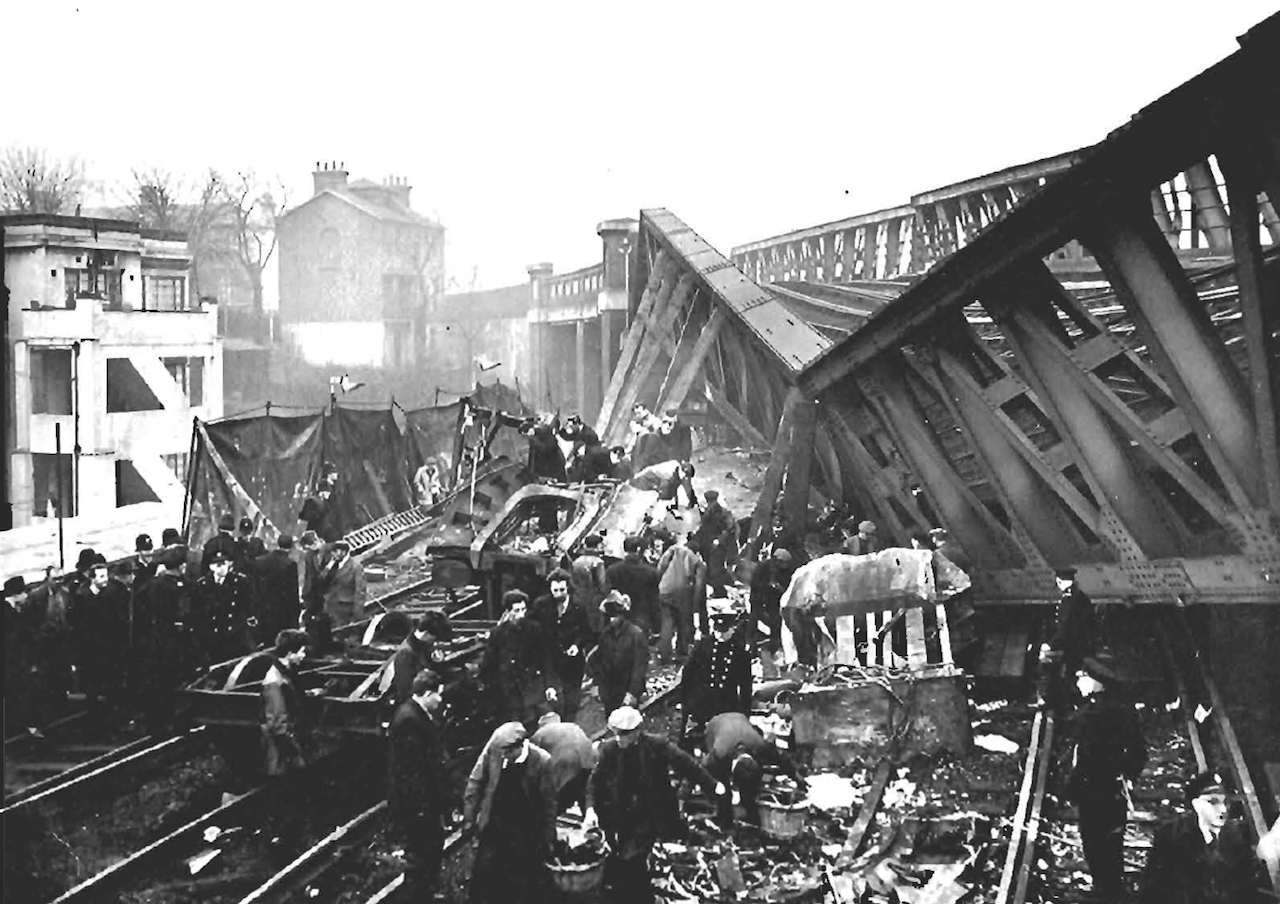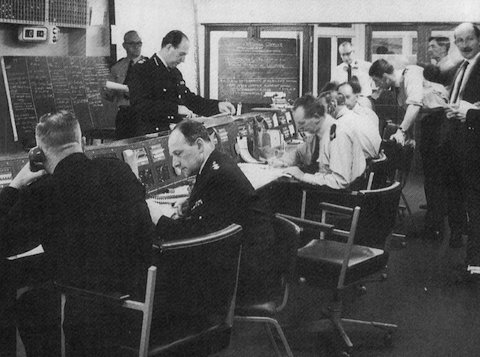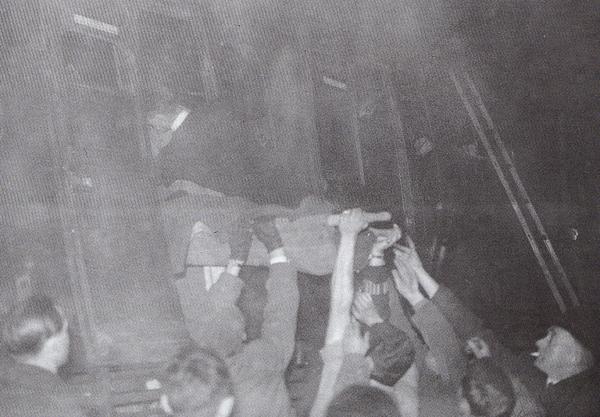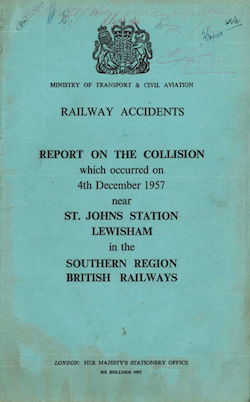 Abraham Lincoln
If given the truth, the people can be depended upon to meet any national crisis...
Abraham Lincoln
If given the truth, the people can be depended upon to meet any national crisis...
 Guildford news...
for Guildford people, brought to you by Guildford reporters - Guildford's own news service
Guildford news...
for Guildford people, brought to you by Guildford reporters - Guildford's own news service
Merrow Woman’s Memories Of The Horrific Lewisham Train Crash 60 Years Ago
Published on: 4 Dec, 2017
Updated on: 7 Dec, 2017
Sixty years ago today (December 4 1957), during thick fog, the 4.56pm Cannon Street to Ramsgate express collided with the stationary 5.18pm Charing Cross to Hayes passenger train at St Johns railway station in the London borough of Lewisham. It resulted in the deaths of 90 people with many more injured.
The Lewisham rail crash, as it is known, has gone down in history as one of Britain’s worst railway disasters.

The crash site at St Johns station in Lewisham as pictured in the official report into the disaster.
Julie Sellars, who now lives in Merrow, was on one of the trains involved on that fateful day and was extremely lucky to survive without even a scratch or a bruise. In a recent taped interview with retired railwayman Geoff Burch, who lives in Worplesdon, she recalled her story of how she climbed out of the wreckage and somehow made her way home.
Geoff has added further details of the trains, the crash and its aftermath.
The collision of the two trains was made worse as the impact brought down the supporting piers of the Lewisham to Nunhead railway bridge which collapsed on to the first three carriages of the Ramsgate train. The driver of a third train travelling from Holborn Viaduct to Dartford managed to make an emergency stop leaving the leading carriage tilting over the bridge’s edge.
Julie recalls: “At the time I worked for the Northern Insurance Company in Eldon Street [London] and my nearest station to get home to Tonbridge was Cannon Street.
“On that day we were told that the office would be closing early because the fog was so intense and that the trains may stop running.
“I got on to the platform with a colleague from work and I usually went right up to the front. But he said there were two seats in the carriage he usually went in, so suggested we sat in there. And that saved my life. I think that was the third coach, or that’s how I recall it.”
In the prevailing dense fog, in which the trains were running very late, the 4.56pm express passenger train from Cannon Street to Ramsgate, via Folkestone, formed of 11-bogie coaches hauled by a “Pacific” type engine, Battle of Britain Class No. 34066 ‘Spitfire’ passed the red aspect of the Down Through colour light inner home signal of St Johns signal box, and collided with the rear of the 5.18pm 10-coach electric passenger train from Charing Cross to Hayes which was standing stationary at the Parks Bridge Junction colour light home signal.
The air brakes of the electric train had been applied to hold it stationary on the rising gradient. As a consequence, the shock of the collision was more severe than it otherwise would have been, and the whole of the body of the eighth coach was destroyed when the underframe and body of the ninth coach were forced over and through it.
In the Ramsgate train the rear of the steam engine’s tender and the front of the leading coach were crushed together and thrown to the left by the sudden stoppage, most unfortunately striking and dislodging the steel middle column supporting the bridge above.
Julie remembers: “We didn’t seem to be going very far then we heard an almighty bang and a jolt and all these people were falling down on the ground, some of the seats were missing and my colleague and I were the only ones left sitting in seats that hadn’t been torn away. I was sitting in a seat facing the train, I don’t know how or why it was still in place.
“It was quite dark outside and because of the fog you couldn’t see anything. It was very eerie. You could hear people shouting for help. You just wanted to run, but didn’t know where to. You were in shock for a while as you didn’t know what was going on.”
The two girders of the bridge subsided at once on to the train below completing the destruction of the leading coach and crushing the second coach and the leading half of the third.
About two minutes later, the 5.22pm eight-coach electric train from Holborn Viaduct to Dartford, which was moving slowly on to the bridge towards a signal at red, was stopped very promptly by the motorman when he saw the girders at an angle; this train was neither derailed nor damaged, but the leading coach was tilted.
Owing to the disorganisation of the train services by the fog, both the trains were crowded, and it is estimated that there were nearly 1,500 passengers in the electric train and about 700 in the steam train. It was inevitable in these circumstances that the casualty list was very great. Ninety persons altogether lost their lives; 88 passengers and the guard of the electric train were killed outright, and one passenger died later of his injuries. Of the 89 fatalities to passengers, there is evidence that 37 occurred in the electric train and 49 in the steam train.
In addition, a large number of persons were conveyed to hospitals in the neighbourhood, where 109 were detained, many with very serious injuries, and 67 others sustained minor injuries or shock.
Julie adds: “The carriage I was in was completely buckled, so you couldn’t open the doors to get out. We didn’t know if it was going to go up in flames, but someone managed to pull a window down. I remember someone saying the lines might still be electrified, and I though ‘oh my God, where do we stand?’.
“The people in my carriage who were ok managed to get out of the window and on to the track. I don’t know whether we got an all-clear to say we could move, but we started to cross the railway tracks but I can’t remember how we got up the embankment.
“There was nobody there to help or give us any indication of what to do. The rescue parties had problems getting down the embankment because of the houses next to it.
“They later directed people to halls or places to congregate. We didn’t see any of that. We started to walk and I couldn’t tell you where, I just followed the chap I was with. He was older than me and was definitely in more shock than I was, after seeing a woman who was trapped and she had asked him to help, but he was told not to as there was a carriage above.
“We found a bus that was going to Sevenoaks, so a number of us got on that. From there we got on another bus that went towards Tonbridge, and I then had to walk the rest of the way home, about a mile.”
Julie wore boots each day, so she could run to and from the station, changing into three-inch high-heel shoes at work. She recalls: “I gave my boots to somebody else in the crash as her’s had gone. I never got my boots back, but I claimed for them and I think I got about 10 shillings and sixpence!
“My mum couldn’t understand why I hadn’t come home. She was listening to the radio, but kept changing the channels and didn’t hear the news.
“In the end she went to the phone box and rang the station to find out what was happening and was told there had been a derailment and all the trains were held up. So she thought everything was all right. I came in around 10 o’clock and I must have looked pretty white, and she said: ‘Where the hell have you been?’ I said I’d been in a train crash and she said: ‘sit down’.
“It was not until I got to my house on that day and fell on the wet or the ice that I got a big bruise on my behind. Otherwise there was not a mark on me.
“I think I was young enough not to be so shocked by it, although I did get the shakes after it for a while. If I was in a train, or perhaps not in a train, I’d suddenly think of what went on and how lucky I was, with not a scratch on me.
“I never spoke to any officials afterwards. There was no counselling, you just had to get on with it. I think I was back at work the following week. But it was quite daunting getting back on to a train.”
The driver of the Cannon Street to Ramsgate train was held solely responsible for the accident.
There is a British Pathé News reel of the Lewisham rail crash that can be viewed on You Tube.
There is another local connection with the Lewisham rail crash in that the now late Sir Peter Matthews (Chief Constable of Surrey from 1968 to1982) was in charge of policing at the disaster.
At the time he was a superintendent in the old “P” Division of the Metropolitan Police, and he made an important contribution to the policing of disasters.

September 1968, and the then Chief Constable of Surrey, Peter Matthews, is seen standing behind the desk in the control room at Mount Browne organising the relief effort after the worse flooding in Surrey within living memory.
In those days the police did not have the advantage of personal radios, but Matthews quickly organised traffic diversions and control points, and set up liaison with other emergency services. More than 120 police officers were involved.
Matthews later made recommendations that led to well-organised casualty index systems, and the provision of incident vehicles containing major-incident boxes of special equipment. His report into the disaster was regarded as a model of excellence, and a copy was placed in the library at the Police College where, to this day, it is still referred to by students.
Responses to Merrow Woman’s Memories Of The Horrific Lewisham Train Crash 60 Years Ago
Leave a Comment Cancel replyPlease see our comments policy. All comments are moderated and may take time to appear.

See Dragon story: GBC’s Explanation of Major Land Sale Notice Error ‘Borders on Arrogant’ Says Councillor







Recent Articles
- City and Manager ‘Part Company’ After Slide in Results
- PCC Election Result – Conservative Lisa Townsend Retains Commissioner Role
- Letter: It’s a Sad State of Affairs
- Times Rankings Showing GBC To Be Worst Council in Surrey Dismissed by Lib Dems
- Birdwatcher’s Diary No.303
- Letter: What a Scoop!
- Filmfest – a Festival of German Films
- Letter: Help Abroad Should Not Be to the Detriment of Those Here
- Armed Police Deployed After Fight at Ash Vale Pub – Four Arrested
- Surrey Schools Could Have ‘Meat-free Mondays’ If Strategy Adopted


Recent Comments
- Frank Emery on Latest Figures Show Two in Every Three Burglaries Went Unattended in Surrey
- Sara Tokunaga on Surrey Schools Could Have ‘Meat-free Mondays’ If Strategy Adopted
- John Lomas on Letter: Jeremy Hunt Has Not Engaged With Ash Parish Council As Claimed
- Jane Austin on Letter: Jeremy Hunt Has Not Engaged With Ash Parish Council As Claimed
- David Humphries on Letter: It’s a Sad State of Affairs
- David Roberts on Letter: Help Abroad Should Not Be to the Detriment of Those Here
Search in Site
Media Gallery
Dragon Interview: Local Artist Leaves Her Mark At One of England’s Most Historic Buildings
January 21, 2023 / No Comment / Read MoreDragon Interview: Lib Dem Planning Chair: ‘Current Policy Doesn’t Work for Local People’
January 19, 2023 / No Comment / Read MoreA3 Tunnel in Guildford ‘Necessary’ for New Homes, Says Guildford’s MP
January 10, 2023 / No Comment / Read More‘Madness’ for London Road Scheme to Go Ahead Against ‘Huge Opposition’, Says SCC Leader
January 6, 2023 / No Comment / Read MoreCouncillor’s Son Starts Campaign for More Consultation on North Street Plan
December 30, 2022 / No Comment / Read MoreCounty Council Climbs Down Over London Road Works – Further ‘Engagement’ Period Announced
December 14, 2022 / No Comment / Read MoreDragon Interview: GBC Reaction to the Government’s Expected Decision to Relax Housing Targets
December 7, 2022 / No Comment / Read MoreHow Can Our Town Centre Businesses Recover? Watch the Shop Front Debate
May 18, 2020 / No Comment / Read More










David Wragg
December 4, 2017 at 7:15 am
I believe that the driver of the steam train was distracted by its poor steaming – a problem caused by poor quality coal – and so missed the red signal.
The force of a heavy steam locomotive hitting the much lighter electric train meant that the passengers in the rear carriages had little chance.
Geoff Burch
December 4, 2017 at 4:29 pm
For a full MOT report on the cause of this tragic accident, please follow link below.
Report On The Collision That Occurred On 4th December, 1957 Near Lewisham In The Southern Region British Railways.
Peter Tatlow
December 6, 2017 at 9:00 am
This was the third most serious railway accident to occur in Britain and is the subject of a book of mine entitled ‘St John’s Lewisham, 50 years on, Restoring the traffic, originally published in 2007 by The Oakwood Press and still in print from Stenlake 54-58 Mill Sq. Catrine, Ayrshire, KA5 6RD.
Ted Sellars
December 8, 2017 at 1:18 pm
This article is about my wife and whilst I was a serving police officer, under Sir Peter, we were at a social function and he was relaying his duties at this train crash. My wife politely told him, he was incorrect on a certain point. Asking her how she knew she told him she was there!
Sapphire Taylor
May 18, 2019 at 9:39 am
My nanny Josephine Taylor was in this train crash sadly she passed away yesterday x
Richard Whittington (PC 304L)
November 23, 2019 at 2:11 pm
I was a police constable serving at Carter Street police station, Walworth. I was unexpectedly sent to the crash at about 6am. Now 2019, I still have vivid memories of what I saw. The worst experience of my life. No counselling then. Back on duty at 6am the next morning.